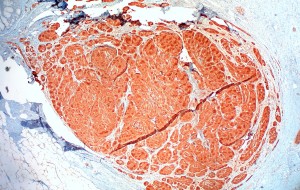Why We Should Study Cancer Like We Study Ecosystems
Like pine beetles sickening a forest as they spread, cancer can be seen as a disruption in the balance of a complex microenvironment in the human body
When pine beetles invaded North American forests, they threw a delicate ecosystem out of balance. Cancer cells, too, behave like damaging invasive species. Photo by Flickr user Kneale Quayle
Sometimes, thinking about an old problem from a refreshing new angle is just the thing needed to find that eureka moment.
Cancer, one of the most notorious medical maladies, has been studied intensely in the current era of modern medicine. But a growing number of researchers think that bringing a fresh, out-of-the-box approach to understanding the disease may lead to some novel insights and, perhaps, solutions. And the subject that they’re hoping can serve as a window into the study of cancer may surprise you: ecology.
On face value, oncology and ecology seem vastly different. For starters, one is localized to specific cells in the body, while the other by definition spans the entire globe. But rather than labeling cancer as a group of mutated cells, as the thinking goes, we should see cancer as a disruption in the balance of a complex microenvironment in the human body. Like a damaging invasive beetle eating its way through forests in Colorado, a novel disease breaking out in populations of wild birds, or loggers mowing down parts of the Amazon rainforest, cancer throws a monkey wrench into an otherwise placid, balanced system.
This way of thinking makes cancer seem even more complex than it already is, but it could provide insights that ultimately make cancer more treatable, propose researchers from the Moffet Cancer Center in a paper published in the journal Interface Focus.
“Einstein is known to have said that everything should be made as simple as possible, but not simpler,” they write. “It turns out that complexity has its place and, as convenient as it would be for cancer biologists to study tumor cells in isolation, that makes as much sense as trying to understand frogs without considering that they tend to live near swamps and feast on insects.”
We tend to think of cancer only in terms of mutated cells, the authors continue. But adopting this narrow approach is like trying to understand why a frog has a sticky tongue without taking into account that frogs use their tongues to catch insects. Cancer cells, likewise, need context. A voracious cancer cell, for example, may situate itself next to a blood vessel not by chance, but so it can obtain more nutrients and oxygen to support its unlimited division.
Cancer cells must compete within the body for nutrients and other resources, just like animals living in an environment must compete with one another in order to survive. This means that cancer, like any organism, must adapt to its environment in order to thrive. The researchers explain:
It is now beginning to be widely accepted that cancer is not just a genetic disease but the one in which evolution plays a crucial role. This means that tumour cells evolve, adapt to and change the environment in which they live. The ones that fail to do so will ultimately become extinct. The ones that do, will have a chance to invade and metastasize. The capacity of a tumour cell to adapt to a new environment will thus be determined by environment and the cellular species from the original site, to which it has already painstakingly adapted.
So how can all of this theory be applied in real life? The environmental approach to understanding cancer is so complex that it rules out normal experiments; they could easily go awry with so many different components to consider. Instead, the researchers suggest turning to mathematics and computational for understanding the greater environmental context that leads to cancer. Ecologists use one such mathematical approach, game theory, as a way to study evolutionary biology and the way animals interact:
The force of natural selection keeps ecosystem denizens focused on optimizing the bottom line: long-term reproduction. In the games studied by evolutionary game theoreticians, individuals compete for available resources using a variety of strategies. These features and behaviours, known as the phenotypic strategy, determine the winners and losers of evolution.
Behavioral strategies may change depending upon both an animal’s nature and the situation’s context. Here’s a hypothetical example, based upon game theory thinking: If two hyenas are digging into a large, tasty wildebeest carcass, they’ll happily share that resource. But if two lions find that same carcass, they will fight for exclusive rights to eating it, meaning one lion emerges victorious and takes all the meaty spoils, while the other gets no food–plus is injured. Finally, if a lion meets a hyena at the carcass, the hyena will bolt, surrendering its goods to the stronger lion. In other words, game theory players can react one of three ways depending upon who they are and what’s going on: they can share, fight or forfeit.

Like a swath of clear-cut jungle or an invasive species slowly spreading out and leaving a trail of damage in its wake, a tumors, like the one above, affects and is affected by the tissue in its surrounding environment. Photo by Flickr user Ed Uthman
Similar games may be played with tumor cells. “A good example would be a tumour with cells that move away when confronted with scarce resources (motile) and cells that stay to use them (proliferative),” the authors write. To make things even more complicated, however, tumor cells are known to change their behavior as they proliferate and metastasize throughout the body, meaning they could switch from a hyena to a lion.
One crucial thing that game theory at an ecosystem level shows us, they continue, is that indiscriminately focusing on killing as many tumor cells as possible might not provide the best outcome for the patient. According to game theory models, the eventual long-term result of the game depends upon specific interactions between the players, not on the number of players involved. Lions will continue to fight one another for food, regardless of whether two lions or 2,000 lions meet. “A treatment based exclusively on indiscriminately removing most (but not all) cancer cells may only have a temporary effect; as in most cases, the original number of tumor cells will eventually be restored and exceeded,” the authors write.
Instead, game theory indicates that a more effective alternative would be based on trying to change the ways that cells interact with one another and with their environment. This may affect the cells’ behavior, strength and reproductive success, the authors explain, which could drive a tumor’s evolution towards less aggressive cell types, or to a more stable coexistence with non-cancerous cells.
“The ecosystem view is, ultimately, a holistic one that sees cancer progression as a process that emerges from the interactions between multiple cellular species and interactions with the tumour microenvironment,” the authors write. “An ecosystem perspective presents us with intriguing implications,” they say, along with a host of questions about how far the analogy between ecosystems and cancer can be taken.
For example, if cancer cells spread like an invasive species through an ecosystem, what evolutionary gain is achieved when the closed off ecosystem (a body) is irreparably damaged (through a person’s death) such that the pestilence also dies? Unlike a virus, which may kill its host but spread to other hosts in the process, cancer cells themselves, for the most part, have no means of spreading from individual to individual. And are cancer cells taking their cues from processes driven by competition or from cooperation? Thinking more proactively, can non-cancerous cells be triggered so that they behave like lions and usurp cancerous cells’ resources until the cancer is manageable?
While ecology and mathematics likely will not defeat cancer on their own, viewing the disease from this perspective could allow doctors to better predict where in the body tumor cells have the best and worst chances of survival, and how to most effectively prevent them from proliferating.
“The heart of the matter is that an ecological view of tumours does not invalidate but complements and builds upon decades of cancer research and undoubtedly this will lead to a better understanding of the biology of cancer and to new and improved therapies,” the researchers conclude. “We need to properly understand the trees (e.g. every leaf, twig and branch) before we can understand the forest but we cannot afford to ignore the forest because the trees are so interesting on their own.”
/https://tf-cmsv2-smithsonianmag-media.s3.amazonaws.com/accounts/headshot/Rachel-Nuwer-240.jpg)

/https://tf-cmsv2-smithsonianmag-media.s3.amazonaws.com/accounts/headshot/Rachel-Nuwer-240.jpg)